AP State Board Syllabus AP SSC 10th Class English Textbook Solutions Chapter 3A The Journey Textbook Questions and Answers.
AP State Syllabus SSC 10th Class English Solutions Chapter 3A The Journey
10th Class English Chapter 3A The Journey Textbook Questions and Answers
Look at the picture and read the following excerpt from the diary of a 72-year-old man. Answer the questions that follow.
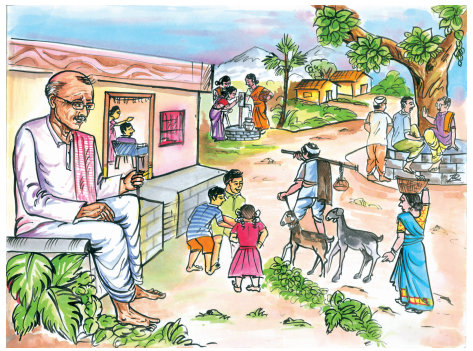
As I sit here alone and waiting
I gaze at people passing me by.
I try to smile and reach out to them
But no one notices; no one waits.
They look to me like I am nothing
Are they afraid to be seen saying “Hi”
to an old man like me?
Question 1.
What is the excerpt about?
Answer:
The excerpt is about an old man’s inner feelings. He feels sorry for himself. Through this excerpt, he tries to tell the readers about his pathetic condition. He feels that he is totally neglected.
![]()
Question 2.
How do people respond to the old man’s smile?
Answer:
When the old man tries to smile and reach out to others, no one notices and no one waits. They look to him like he is nothing. The old man feels that they are afraid to be seen saying “Hi” to an old man like him.
Question 3.
How should old people be treated so that they do not feel neglected?
Answer:
The old people should be treated equally. They should be respected and treated with honour. They should not be bullied or laughed at. We should share our feelings with them. We should give value to their feelings. We should obey them and try to follow their pieces of advice. If we treat the old people as mentioned above, they don’t feel neglected.
I. Answer the following questions.
Question 1.
‘After spending a leisurely Sunday at home, the very thought of returning to work on Monday is tiring.’ Do you agree? Have you ever felt so?
Answer:
Yes, 1 agree to the above statement. After spending a leisurely holiday at home, the very thought of returning to work on the next day is tiring to anyone. I have felt so many a time. I felt so after Dussehra holidays, Pongal holidays and summer vacation previously. It would be a difficult day for me going to school on the very first day after the holidays are over.
Question 2.
The last sentence of the first paragraph and the first sentence of the second paragraph appear to contradict each other. What could be the reason for the change in the decision?
Answer:
The last sentence of the first paragraph says that the author didn’t want to go but the first sentence of the second paragraph says that the author decided to go finally. Both the sentences contradict each other. At first he didn’t want to go as he had got married. He didn’t want to leave behind his newly-wed wife. But, when he remembered his increased responsibilities because of his marriage and his debts, he decided to return to work.
Question 3.
‘Why did the author get into debt? Think of some possible reasons.
Answer:
The author felt that he had got into debt after his marriage.
The possible reasons are :
i) The author might have met his marriage expenses.
ii) He spent leisurely at home for about six months without going to work.
iii) The increased expenses for the new couple.
iv) The author might have bought new furniture.
v) He might have bought a new flat.
vi) He might have bought a number of sarees for his newly-wed wife.
vii) He might have spent money carelessly.
viii) He might have given money to his old parents.
Question 4.
Why was the author reluctant to carry his own luggage? What would you do if you were in the author’s place?
Answer:
The author was reluctant to carry his own luggage as he had the feeling that if he carried the luggage, the whole world would laugh at him. He thought that his education had made him shun physical labour. In fact, the author looked for someone’s help. He felt that his guilt, shame, self-consciousness and pride might have stopped him from carrying the luggage. If I were in the author’s place, I would not do like he did. I would myself carry the luggage without looking for others’ help.
![]()
Question 5.
The author feared that the whole world would laugh at him if he carried the trunk. Was the fear imaginary or real? Give reasons for your answer.
Answer:
The author feared that the whole world would laugh at him if he carried the trunk. I think his fear was imaginary. No one laughs at us when we do our work. In fact, carrying the trunk should not have been such a worry for him. For a young man like the author it should not have been an issue to carry his luggage on his back. Actually the others will praise his modesty, if he carries his luggage himself.
Question 6.
Choose one sentence from the story that best expresses the author’s false prestige. Support your answer with details from the story.
Answer:
“Somehow, I had the feeling that if 1 carried the luggage, my father and my people, in fact the whole world would laugh at me and I would be belittled,” – this sentence expresses the author’s false prestige. He thought that his education had made him avoid physical labour. As a government officer, he didn’t accept the idea of people seeing him carry his own luggage. He was of the opinion that it was through him that his parents had earned a greater degree of admiration and respect from the villagers. He felt that his father would not like to see him carrying a trunk on his back and would be very hurt if he did so. These are all the facts which show the author’s false prestige.
Question 7.
What does the phrase ‘opposite directions’ in the last sentence suggest?
Answer:
When the bus started moving, the author saw his father gradually receding into the distance. The author felt that their journeys started in two opposite directions, with him seated in the luxurious seat of a bus and father walking back with tired legs on the pebble-strewn road. The phrase ‘opposite directions’ suggests that both their directions were different. Actually, the son and the father had to travel in opposite directions to reach their destinations. In the other sense, the writer’s way was a luxurious one as he was an educated one and a government officer. He didn’t need to lead such a hard and laborious life like his father used to lead. When compared with his life, his father’s life was much harder one.
Question 8.
How was the story told? Were the events narrated in the order in which they had happened? Spot the sentences where the course of narration changed its direc¬tions. How effective was it?
Answer:
‘The Journey’ is a beautiful narrative by Yeshe Dorjee Thongchi. Most of the events were narrated in the order in which they had happened. Here and there we find that the narration changed its directions.
The sentences where the course of narration changed its directions:
a) “I did not have much to carry byway of luggage – just a trunk. Ours is a hilly terrain
Here the author tried to give the reason. Then he explained the purpose of his coming to his place. Thus, the course of narration was changed.
b) “Nobody had time to spare for me. In fact, carrying the trunk should not have been such a worry”
The course of narration was changed after the first sentence when the author tried to tell us about his inner feelings.
c) “We were walking up a narrow hilly road and neither of us uttered a word as if we were strangers who spoke different languages. I did not know what was going on in his mind.”
When we observe the two sentences given above, the first one changed its direc¬tion when the author tried to present his thoughts.
d) “Father wanted to say something but the bus started moving.” Later the narrative was changed its course when the author tried to think about his way in comparison with his father’s.
A reader could understand very well about the author’s inner thoughts by this way of narration. He too would try to think in his own way imagining that if he were in the author’s place. Thus it was effective in provoking the thoughts.
II. Write the number of the paragraph that gives the stated information in each of the following sentences.
1. The author enjoyed his married life.
Answer:
Paragraph 1 (The first paragraph)
2. The author tried to convince himself that he had not done anything wrong.
Answer:
Paragraph 11.
3. The author was ashamed of making his father carry his trunk.
Answer:
Paragraph 10.
4. The author looks at himself and his father as two travellers taking two different roads.
Answer:
Paragraph 16 (The last paragraph).
III. The following statements are false. Correct them.
1. The author offered to carry the trunk for some time.
2. The author could decide on whether to allow his father to carry the trunk or not.
3. The author took unpaid leave.
4. The father was not happy with the old shoes his son gave him.
Answer:
Corrections:
- The author didn’t carry the trunk at all throughout the story. His father carried it all the way.
- The author decided that it would be better to let his father carry the trunk.
- The author initially thought of taking unpaid leave but later he decided against it.
- The father was happy with the old shoes his son gave him. His face lit up with content-ment when he noticed the author taking out his pair of shoes from the trunk.
Vocabulary
I. Look at these words from the story :
1. newly-wed wife
2. bus stop
3. forehead
They are all compound words. A compound word is a union of two or more words to convey a unit idea or special meaning that is not as clearly or quickly conveyed by separated words. As shown above, compound words may be hyphenated, written open (as separate words), or written solid (closed). The use of compounding in English is an evolving process. As expressions become more popular or adopt special meanings, they follow a gradual evolution from two or more separate or hyphenated words to single words.
| audio visual | audio-visual | audiovisual |
| copy editor | copy-editor | copyeditor |
| wild life | wild-life | wildlife |
The words in the first, second and third columns are called ‘open compounds’, ‘hyphenated compounds’ and ‘closed compounds’ respectively. In this unit we focus on hyphenated compounds.
A hyphenated compound is a combination of words joined by a hyphen or hyphens. Here, the hyphen aids understanding and readability and ensures correct pronunciation. Words are hyphenated mainly to express the idea of a unit and to avoid ambiguity.
![]()
A. Pick out all the compound words from the story and group them under the head-ings as explained above.
| Open compounds | Hyphenated compounds | Closed compounds |
| 1. bus stop | 1. newly-wed | 1. anyone |
| 2. government officer | 2. far-off | 2. someone |
| 3. tea shop | 3. 20-kilo | 3. forehead |
| 4. each other | 4. home-made | 4. moreover |
| 5. bare feet | 5. matter-of-fact | 5. myself |
| 6. self-consciousness | 6. anyway | |
| 7. white-collar | 7. childhood | |
| 8. pebble-strewn | 8. useless | |
| 9. anything | ||
| 10. somehow |
B. Fill in the blanks to make hyphenated compound words. Refer to a dictionary and get the meaning. Write a few sentences using them appropriately.
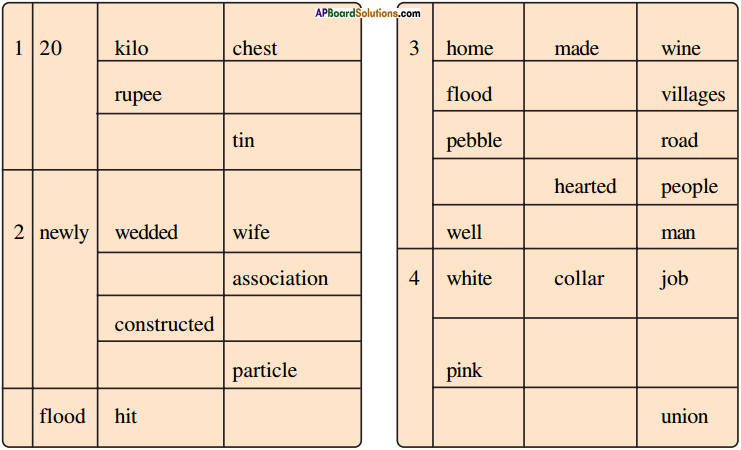
| 1. | 20 | kilo | chest |
| rupee | note | ||
| inch cake | tin | ||
| 2. | newly | wedded | wife |
| formed | association | ||
| constructed | building | ||
| discovered | particle | ||
| 3. | flood | hit | area |
| home | made | wine | |
| flood | hit | villages | |
| pebble | strewn | road | |
| kind | hearted | people | |
| well | mannered | man | |
| 4. | white | collar | job |
| pink | card | holder | |
| new | tradp | union |
Own Sentences:
1. a) He can easily lift a 20-kilo chest.
b) My father gave me a 20-rupee note.
c) We ordered a 20-inch cake tin and it has just been delivered.
2. a) Mr. Prakash came to his native place along with his newly-wedded wife.
b) The newly-formed association held an important meeting yesterday.
c) Theirs is a newly-constructed building.
d) The scientists declared that it was a newly-discovered particle-
e) The CM has visited the flood-hit area.
3. a) They served the home-made wine in the party.
b) The officials listed out the flood-hit villages.
c) I have to walk over pebble-strewn road to reach the temple.
d) They are kind-hearted people; they have made their contribution in building this hospital.
e) Mr. Rajan is a well-mannered man; he always tries to be friendly with others.
4. a) Mr. Ravi Teja was offered a white-collar job.
b) Mr. Bharat is a pink-card holder, who is eligible to take all the fair-price goods.
c) Yesterday, they formed a new-trade union.
![]()
C. Fill in the blanks with the missing parts of compound words.
Kedarnath lived in Uttarakhand. Due to heavy rains, his village was hit by floods. His newly ____(1) ____ house fell down and he became ______(2)_____ less. The Chief Minister visited all the _____ (3) ____ hit villages and announced immediate help. However, Kedarnath lost his self ____(4) ____ and tried to commit suicide by jumping into the flooded river. Some brave and ____(5) ____ hearted people rescued him risking their lives. They told their stories too. Someone had lost his ____(6) ____ wedded wife, and someone else had lost all his family members. One of them offered him a ____(7) ____ collar job. It required him to carry rice bags. But he could not carry even a 20 ____(8) ____ bag, so he asked for a ____(9) ____ job. But no such jobs were available. One of them suggested ____(10) ____ employment scheme. But Kedarnath had no money. One day as he was walking on the pebble ____(11) ____ road, he found some ____(12) ____ plated idols and jewellery in a box.
Answer:
- built (newly-built)
- home (homeless)
- flood (flood-hit)
- confidence (self-confidence)
- kind (kind-hearted)
- newly (newly-wedded)
- blue (blue-collar)
- kilo (20-kilo)
- white-collar
- self (self-employment)
- strewn (pebble-strewn)
- gold (gold-plated)
II. Look at the word ‘dilly-dally from the text. This is a reduplicative word. The words super-duper and bye bye are also reduplicative words. But they belong to different categories shown below:
1. Duplicative type :
Here, the first part of the word is repeated without any change.
e.g.: bye bye
2. Alliterative type :
Here, the two parts have the same consonants but different vowels.
e.g. : dilly-dally, chit-chat
3. Rhyming type :
Here, the second word starts with a different consonant but rhymes with the first part.
e.g. : super-duper
A. Look at the following reduplicatives carefully and put them under proper headings in the table given below.


Answer:
| Duplicative | Alliterative | Rhyming |
| aye-aye | ding-dong | bow-wow |
| chuk-chuk | ping-pong | easy-peasy |
| bang-bang | zig-zag | okey-dokey |
| chop-chop | see-saw | hodge-podge |
| tata | hip-hop | helter-skelter |
| papa | chit-chat | itsy-bitsy |
| ha ha | pitter-patter | nitty-gritty |
| boo-boo | tip-top | hanky-panky |
| hush-hush | tick-tock | teeny-weeny |
| night-night | mish-mash | hurly-burly |
Reduplicatives are used in a variety of ways. Some simply imitate sounds: ding- dong, bow-wow. Some suggest alternative movements: flip-flop, ping-pong. And some intensify meaning: teeny-weeny(very small), tip-top(very good).
Find the meanings of the words you like and use them in your own sentences. You will find similar words in your language too. For example, in Telugu, we have words like chi-chi, pho-pho, kaadu-kaadu, tara-tama, taado-pedo, pilla-jella, auto-ito. Give some examples from your language. Don’t they sound musical?
Reduplicative Words in Telugu
B. Answer each of the following questions using a reduplicative word.
1. What does the clock say? ____________________
2. What does the school bell say? ____________________
3. How does the rain drop? ____________________
4. What does the dog say? ____________________
5. How do you laugh? ____________________
Answer:
- tick-tock
- ding-dong
- pitter-patter
- bow-wow
- ha ha
Grammar
I. In this story the author used past perfect tense (had + past participle) in many sentences. If you observe the following sentences from the story and the rules given under them, you will understand why and how the past perfect tense is used.’
1. It was 10.20 My father had already left, (para 6)
Answer:
When an action takes place before a point of time in the past, the action is expressed in the past perfect tense. (Sometimes the point of time can be understood from the earlier sentences and other contextual clues.)
2. Finally we reached Dirang. The bus from Tawang had not yet reached Dirang. (para 11)
Answer:
When two actions in the past are clearly separated by time, the earlier action is expressed in the past perfect tense.
![]()
3. I quickly sat down on a rock. My father laughed at my plight, (para 7)
Answer:
When two actions in the past happen simultaneously, both of them are expressed in the past tense.
4. a) Sunitha never saw a bear before she was transferred to Maredumilli. (not from the story)
b) Shindh closed the doors because she heard loud noises from outside.
c) I never met him after I left India.
Answer:
Normally, when the time relation is unambiguous, (by the use of before, after, because, etc.), the simple past (past perfect is optional) is used to refer to both past actions.
Comment on the use of the simple past tense/past perfect tense (as illustrated above) in the following sentences. Identify the tense and give reasons for the use of the tense used.
1. I had come home this time round for a special purpose: to get married. My parents had arranged my marriage according to the customs of our tribal society.
Answer:
In both the sentences, the part perfect tense is used as those two actions had already completed before his narration, (had come, had arranged)
2. Time flew, and five months into my marriage I realized it.
Answer:
In the above sentence both the verbs are in the simple past tense as the time relation is unambiguous and those two occur in the past simultaneously.
3. But after some dilly-dallying I finally decided against it because marriage had increased my responsibilities and I had got into debt.
Answer:
“Marriage had increased my responsibilities and 1 had got into debt.” – These two actions occurred before “I finally decided against it.” Hence, in the earlier two actions the past perfect tense is used while the simple past tense is used in the latter.
4. On my way home from the bus stop my trunk had been carried by a porter, (para 3)
Answer:
The above action occurred before his narrating the story. Hence, the past perfect tense (had been carried) is used.
5. A large crowd gathered at our place the day I was to leave. People had come to wish me luck, (para 6)
Answer:
A large crowd gathered at our place the day I was to leave. → In this sentence the simple past tense is used as it occurred later.
People had come to wish me luck. → In this sentence the past perfect tense is used as it occurred earlier.
People had come and then the large crowd gathered. Hence, the two tenses are used.
6. Father was quiet for some time. He thoughtfully looked at the sun for a moment, and then his eyes fell on the can of home-made wine that I was carrying, (para 9)
Answer:
The actions in the above sentences occurred in the past simultaneously. Hence, the simple past tense is used in all the actions except the last part of the second sentence. ” ……….. that I was carrying.” Here the past continuous tense is used as it was going on at the time of narrating.
![]()
7. I gave him the can of wine. He poured himself a mug and handed me the can. He drank all of it at one go. He then arranged the belt that was attached to the trunk carefully on his forehead. (para 10)
Answer:
All the actions are in the simple past tense as they all occurred in the past simultaneously and also the time relation is unambiguous.
8. I had never got used to physical labour having stayed in hostels right from my childhood. (para 11)
Answer:
“I had never get used to …………”
Here the past perfect tense is used as the author while narrating, went intq the past and told. Hence, the past perfect tense is used.
9. His feet had developed cracks and somehow resembled those of an elephant. (para 14)
Answer:
When two actions in the past are clearly separated by time, the earlier action is expressed in the past perfect tense. “His feet had developed cracks” …. This action took place before “his feet resembled those of an elephant.” Hence, the earlier action is expressed in the past perfect tense and the latter is expressed in the simple past, (had developed, resembled)
10. I noticed this for the first time. 1 hadn’t noticed that the road was uneven, (para 14)
Answer:
“I noticed this for the first time.”
Here the simple past tense is used as it is the author’s narration.
“I hadn’t noticed that …….. ”
This action might have occurred if the author did it but this action didn’t take place. Hence, the past perfect tense (+ not) is used.
” the road was uneven.” The condition of the road was mentioned here. It was
the condition of the road when he narrated. Hence, the simple past tense is used.
11. I checked my wallet and saw I still had around Rs.40 with me. (para 14)
Answer:
Both the actions in the above sentences occurred in the past simultaneously. Hence, the simple past tense is used in both the contexts.
![]()
12. I then took out my pair of leather shoes from the trunk, and noticed my father’s face lighting up with contentment, (para 15)
Answer:
The above two actions occurred in the past simultaneously and the time relation is unambiguous. Hence, the simple past tense is used, (took, noticed)
13. I saw that the road we had come by looked like a giant motionless rope, (para 16)
Answer:
“I saw that ” — Here the past tense is used to refer to the past action as it is the writer’s narration.
” ………… we had come by looked …………”
— Here the past perfect tense is used as this action had completed before his narration.
” …………… looked like a giant motion rope.” — Here the simple past tense is used to refer to the action as it is the writer’s narration.
14. He stopped his business after he became old.
Answer:
In this sentence both the verbs ‘stopped’ and ‘became’ are in the past tense as the time is unambiguous.
15. I never ate ‘haleem’ before I visited Hyderabad.
Answer:
In this sentence the verbs ’ate’ and ‘visited’ are in the past tense as the time is unambiguous.
II. Adverbial Clauses
Study the following examples from the story.
1. As I had to do a bit of catching up, I walked fast.
2. As I was going to take my first sip. 1 heard father’s voice.
3. He decided to go to his work place because he got into debts.
In all the above sentences there are two clauses. The underlined part is the adverbial clause.
There are several types of adverbial clauses.
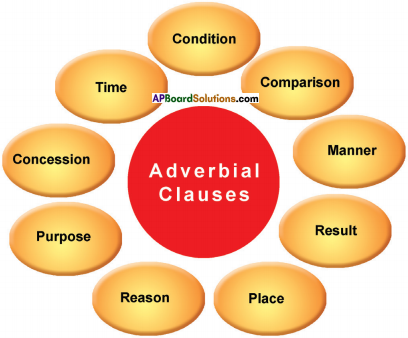
Combine the pairs of sentences by using the words given in brackets.
1. There was nobody in the village to carry the author’s luggage. Everbody was engaged in some important work, (because)
2. The roads were not good. He preferred less luggage, (as)
3. He wanted to stay at home for some more days. He wanted to apply for leave, (since)
4. You may not attend the class. You don’t want to come again, (if)
5. The boy was about to come down the stairs. Then it crumbled down, (when)
Answer:
- There was nobody in the village to carry the author’s luggage because everybody was engaged in some important work.
- As the roads were not good, he preferred less luggage.
- Since he wanted to stay at home for some more days, he wanted to apply for leave.
- If you want to come again, you have to attend the class.
- Whan the boy was about to come down the stairs, it crumbled down.
More about Adverbial Clauses :
1. Adverbial Clauses of Time :
Adverbial Clauses of Time are introduced by the subordinating conjunctions when-ever, since, after, before, while, as, etc.
e.d.:
1) As Bayaji came home, his children returned.
2) As soon as the bell rang, the children came out crying.
3) While Sachin was batting, there was a heavy noise all over the stadium.
2. Adverbial Clauses of Place :
Adverbial Clauses of Place are introduced by the subordinating conjunctions where and whereas.
e.g.:
1) You can go wherever you like.
2) I want to live where you live.
3. Adverbial Clauses of Reason :
Adverbial Clauses of Reason are introduced by the subordinating conjunctions because, that, as, since.
e.g.:
1) Because he was ill, he didn’t come.
2) He was very happy that his son had passed.
3) As she was absent from school, the teacher punished her.
4. Adverbial Clauses of Manner :
Adverbial Clauses of Manner are introduced by the subordinating conjunctions like, as, as if.
e.g.:
1) He finished the work as she requested.
2) He is acting like he doesn’t like her.
3) They talked as if they had read.
5. Adverbial Clauses of Purpose :
Adverbial Clauses of Purpose are introduced by the subordinating conjunctions so that, in order that and lest
e.g.:
1) Work hard lest you should fail.
2) We eat so that we may live.
3) Sunlight is needed in order that the process of photosynthesis takes place.
6. Adverbial Clauses of Condition :
Adverbial Clauses of Condition are introduced by the subordinating conjunctions if, whether, unless.
e.g.:
1) Unless you work harder, you will fail.
2) If I go to Hyderabad, I will meet your brother.
3) She was uncertain whether to stay or leave.
7. Adverbial Clauses of Consequence :
Adverbial Clauses of Consequence are introduced by the subordinating conjunction that.
e.g.:
1) She is such a kind man that all love him.
2) She speaks in such a low voice that nobody can hear her.
8. Adverbial Clauses of Comparison :
Adverbial Clauses of Comparison of Degree are introduced by the subordinating conjunction than, or by the Relative Adverb as …. as.
e.g.:
1) She is younger than he.
2) He is as stupid as he is lazy.
9. Adverbial Clauses of Concession :
Adverbial Clauses of Concession are introduced by the subordinating conjunctions though, although, even if.
e.g.:
1) Though he is poor he is honest.
2) Even if it rains 1 shall come.
3) He passed in first division although he didn’t work hard.
Writing
I. In the story ‘The Journey’ the author says “…. my education had made me shun physical labour”. This is an adverse effect of education. Now write an essay on ‘The Adverse Effects of Education’. Here are some points:
Effect on
• doing some work that involves physical labour
• dress/fashion
• family relationships
• giving respect to elders
• the treatment of illiterate people
Answer:
The Adverse Effects of Education
It is a well-known fact that education plays a vital role in bringing up both economically and socially. It is thought that education helps people in so many ways. Highly educated people are enjoying the status in the present day society. People with high education attain a good job, more money and many other benefits. A literate person can show the right path to others. We usually think of the benefits of education only but we should not ignore the adverse effects of education.
When the pupils spend all their time in reading and writing, there is no scope for them to do any other work. They don’t find time even to play games. Their education makes them physically weak. They are unable to do any work that involves physical labour. “A sound mind in a sound body” is a proverb. Both the sound mind and the sound body are needed if one desires to be successful. When we are helathy, we can perform our functions regularly and properly. Today, most of the pupils stay in hostels right from their childhood. Hence, they never get the chance to do physical labour. One’s physical labour will make oneself both physically and mentally strong. But today’s education system doesn’t allow the pupils to do physical labour. And the other thing is that the educated people think that others will laugh at them if they do any kind of physical labour. They think that theirs is an important position in the society. Doing their own things is the point of prestige for them. Their false prestige makes them think in a wrong way.
The second point is their dress sense. The persons with high education try to wear fashionable dresses which are different from other ones. As far as the educated Indians are concerned, they give more value to the western culture. They try to adapt the foreigners’ culture. They never think of our culture and traditions. They think that only illiterate people wear such kind of dresses which reflect our culture. In their view, they will be degraded if they don’t wear modern dresses. This thought only leads to other social problems. The young women’s dress sense will cause them a threat. They think that they are superior to the uneducated ones and behave arrogantly.
Another important point is how education affects the family relations. When a person completes his education, he starts thinking that he is greater than the other uneducated members of his family. He wants to show his dominance. If he gets employment, he doesn’t find time to spend with them. He always thinks about earning money. He gives importance to money only. He doesn’t show any love and affection even for his parents. Thus, one’s education leads to the absence of human relationships.
Most of the literates don’t give any respect to elders. As Indians, we generally have faith in our values, traditions and culture. What we have learnt from our ancestors is that we should give utmost respect to our elders. At present, we witness a different scenario. Some educated persons think that there is no use of elders. They forget the sacrifices made by them. They ill-treat their family members who are illiterates. This will lead to the destruction of family relationships.
No doubt, there are so many advantages with the education one gets. But one’s education makes one senseless. The educated persons must not move away from physical labour. They must do some work that involves physical labour. They should take care about their dress. They should not deviate from our traditional way of dressing. They should maintain good family relationships. They should respect elders. They should treat the illiterate people with courtesy. Then only their education is meaningful.
II. Summarising
A few guidelines and tips to summarize a text are given below. Read them carefully. Then read the essay ‘On Umbrella Morals’ and summarize it.
Guidelines and tips to summarize a text
To summarize is to condense a text to its main points and to do so in your own words. To include every detail is neither necessary nor desirable. In order to write a good summary, you may have to gather minor points or components of an argument from different places in the text in order to summarize the text in an organized way. A point made in the beginning of an essay and then one made toward the end may need to be grouped together in your summary to concisely convey the argument that the author is making.
Here are a few key points:
- Read the article carefully – as many times as you require!
- Begin your summary by mentioning the author and title. The publication and date may also be mentioned.
- Summarize in your own words in third person using simple present tense.
- Use transition words (however, moreover, then, also, etc.).
- Avoid unnecessary details and direct quotes.
- Do not give your own opinion.
- Keep it within the word limit given or one third of the original text.
- Prefer short and simple sentences.
- Be consistent with the tense.
- Check for grammar and punctuation errors.
Read the following essay.
On Umbrella Morals
-Alfred George Gardiner
A sharp shower came on as I walked along the street, but 1 did not put up my umbrella. The truth is I couldn’t put up my umbrella. The frame would not work for one thing, and even if it had worked, I would not have put the thing up, because it was falling to pieces and I would be the laughing stock. The fact is, the umbrella is not my umbrella at all. It is the umbrella of some person who I hope will read these lines: He has got my silk umbrella. I have got the cotton one he left in exchange. I imagine him walking along the street under my umbrella, and throwing a scornful glance at the fellow who was carrying his ugly thing. I dare say the rascal laughed silently as he eyed the fool with his cotton umbrella. He is one of those people who have what I may call an umbrella conscience.
I hope you know the sort of person I mean. He would never put his hand in another’s pocket, or forge a cheque or rob a cashbox —not even if he had the chance. But he will swap umbrellas, or forget to return a book, or take a rise out of the railway company. In fact he is a thoroughly honest man who allows his honesty the benefit of the doubt. Perhaps he takes your umbrella at random from the barber’s stand. He knows he can’t get a worse one than his own. He may get a better one. He doesn’t look at it very closely until he is well on his way. Then, “Dear me! I’ve taken the wrong umbrella,” he says, with an air of surprise, for he likes really to feel that he has made a mistake. “Ah, well, it’s no use going back now. He’d be gone. And I’ve left him mine! “It is thus that we play hide-and-seek with our own conscience. It is not enough not to be found out by others; we refuse to be found out by ourselves. Quite impeccable people, people who ordinarily seem unspotted from the world, are afflicted with umbrella morals.
It was a well-known preacher who was found dead in a first-class railway carriage with a third-class ticket in his pocket. And as for books, who has any morals where they are concerned? I remember some years ago the library of a famous divine and literary critic, who had died, being old. It was a splendid library of rare books, chiefly concerned with seventeenth-century writers, about whom he was a distinguished authority. Multitudes of the books had the marks of libraries all over the country. He had borrowed them and never found a convenient opportunity of returning them. They clung to him like pre-cedents to law. Yet he was a holy man and preached admirable sermons, as I can bear witness. And, if you press me on the point, I shall have to own that it is hard to part with a book you have come to love.
It is possible, of course, that the gentleman who took my silk umbrella did really make a mistake. Perhaps if he knew the owner, he would return it with his compliments. After my experience to-day, I think I will engrave my name on my umbrella. But not on that baggy thing standing in the corner. I do not care who relieves me of that. It is anybody’s for the taking.
Study Skills
Use the following graphic organizers to represent your understanding of the story ‘The Journey’. Modify the layout to suit your needs.
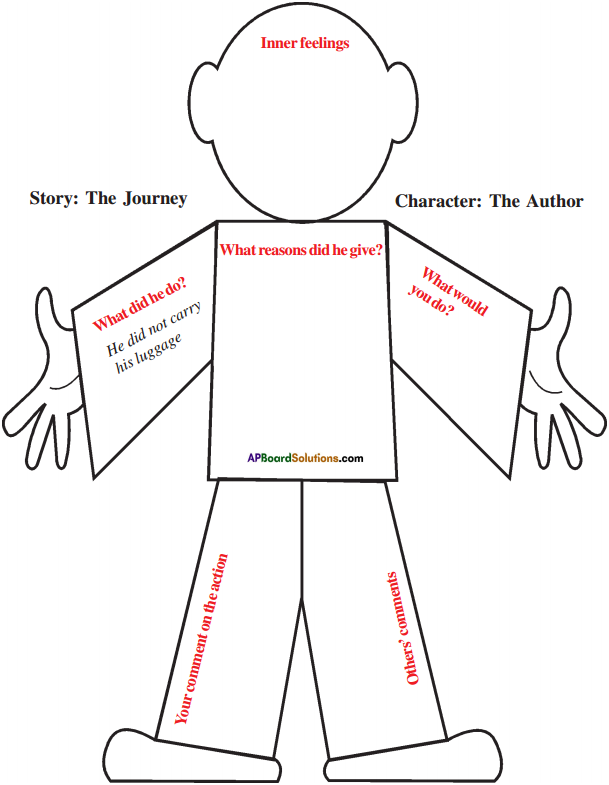

i) 1. How could I allow my old father to carry my trunk?
2. What would people think?
3. What would they say?
4. It was improper for me to let father carry the luggage.
5. It was through me that they (my parents) had earned a greater degree of admiration and respect from the villagers.
6. He was stronger and more skilled than I in these matters.
ii) 1. His education had made him shun physical labour.
2. His father, his people, and the whole world would laugh at him and he would be belittled.
3. His father would not like him to see him carrying a trunk on his back.
![]()
iii) I would myself carry my luggage. I wouldn’t make my father carry it.
iv) The author’s action is inhuman. He is thankless and selfish.
v) The author is ungrateful. He doesn’t show any respect, love, and affection for his father.
Listening
Listen to the story and answer the questions that follow.
Once there was a very rich man. His name was Dhanaraju. He had two sons, Ganiraju and Pothuraju. Ganiraju was hard working and obedient. He always helped his father in the fields. But Pothuraju was lazy. He never went to fields. He was disobedient to his father. He always wanted to lead a free, lavish life, so one day he said to his father, “Father, give me my share of property.” The father was heart-broken. He divided the property between his two sons. Pothuraju left home with his share. He went to a distant land, made a lot of friends and soon spent all his property lavishly on friends, food and drinks. All his friends left him.
At that time, there was a famine and Pothuraju had no work and food. None of his friends gave him food or money. He took up the job of feeding pigs. Sometimes, he had to eat the food kept for the pigs. He was very sad about his condition. He soon began to think of his father and his brother. He said to himself, “In my father’s house, even the servants have enough food. They get good shelter too. But here, I am struggling for food and shelter. I will go back to my father. 1 will beg him to take me as his servant.”
So decided, the dishonest son set out for his father’s house. In the meantime, his father was always thinking of his second son. He would sit near the windows. He would look out at the road, expecting his son to return home.
One day Dhanaraju saw his son coming at a distance. He rah out of the house in great joy and hugged his son. His son knelt down. He said, “Father, 1 am not fit to be your son. Take me as your servant.”
I. Read the statements given below and mark True or False against each of them.
1. Pothuraju went to far-off lands to enjoy free life.
2. Ganiraju asked his father to give his share of property.
3. Pothuraju had a lavish life from the beginning.
4. Dhanaraju did not care about Pothuraju.
Answer:
1. True
2. False
3. False
4. False
II. Which of the following is the most appropriate title for the story you have just listened to?
a) A Rich Son
b) Repentance
c) Two Sons
Answer:
(b) Repentance
The Journey Summary in English
The Journey’ is an excellent piece of work written by Yeshe Dorjee Thongchi, a prominent Assamese writer and it is translated into English by D.P. Nath. The author was a government officer. He came to his village to get married. His parents had arranged his marriage, according to the customs of their tribal society. After spending six months at home, he was preparing to return to his place of work. But he didn’t want to leave behind his newly-wed wife. He thought of extending his leave too. But his responsibilities made him decide to go.
As theirs is a hilly terrain, without any motorable roads, the author always prefers to carry less luggage. Now, his problem was that he needed someone to carry his luggage as his education had made him avoid physical labour. Since most of the villagers were busy in the fields, he couldn’t find even one who could help him carry the trunk to the bus stop. Finally, the writer’s father told him that he would see him off at Dirang. He didn’t want to allow his old father to carry his trunk and so he protested. But his father decided to carry the chest to the bus stop. On the day of his departure, a large crowd gathered to wish him luck and the author left for Dirang at 10 : 20. His father had already left and he had to walk fast to catch up his father. He was very tired when he caught up with his father. He sat on a rock to rest for a while. His father drank all the wine given by him and resumed carrying the luggage on his back. The author followed his father. Neither of them spoke a word as if they were strangers. The author thought that it was improper for him to let his father carry the luggage. Although he wanted to tell his father that he would like to carry the trunk himself, he couldn’t do so because of his guilt, shame and pride. He felt that the whole world would laugh at him if he did so.
The author knew that his father had provided for his education. He thought that it was through him that his parents had earned admiration and respect from the villagers. He knew that he was physically useless in spite of his youth and strength. He concluded that it would be better to let his father carry the luggage and followed him silently After resting at two places for tiffin, they reached Dirang finally. They entered a tea shop and started sipping tea. His father asked him if he had a pair of old shoes. Then the author looked at his father’s bare feet and noticed that they were full of cracks. He noticed this for the first time. He offered his father money but he refused to take. Instead, he wanted the author’s old pair. So, the author gave him the hunting boots he was wearing. His father filled with satisfaction when he saw the author taking out his pair of leather shoes from the trunk. His father wanted to say something to him but the bus started moving. Finally the author realized that both their ways were different – his way was a luxurious one while his father’s was a difficult one.
The Journey Glossary
lethargy (n) : the state of not having any energy or enthusiasm for doing things
creeps (v) : develops very slowly
terrain (n) : a particular type of land
extend (v) : to continue for a longer period of time
dilly-dallying (v) : taking a long time to do something, go somewhere or make a decision
debt (n) : a sum of money that a person or organization owes
shun (v) : to avoid something or somebody
chest (n) : a large strong box
see off (phr.v.) : to go to an airport, station, etc. to say goodbye to someone
protest (v) : to say that one strongly disagrees with
dissuade (v) : to convince somebody not to do something
catch up (phr.v.) : to come from behind and reach someone in front of you by going faster
plight (n) : a difficult and sad situation
utter (v) : to say something
guilt (n) : the unhappy feelings caused by knowing that you have done something wrong
self-consciousness (n) : feelings of nervousness about what other people think of you
belittle (v) : to make someone or something seem small or unimportant
hardly (adv) : almost not
sip (n) : a very small amount of a drink
pebbles (n) : small smooth stones
bare feet (n.phrase) : the feet without chappals or shoes
contentment (n) : a feeling of happiness or satisfaction
recede (v) : move back from a previous position further and further until it disappears
weary (adj) : very tired
pebble-strewn road (n.phrase) : the road over which pebbles are scattered

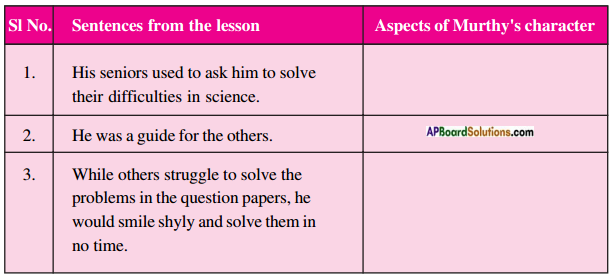
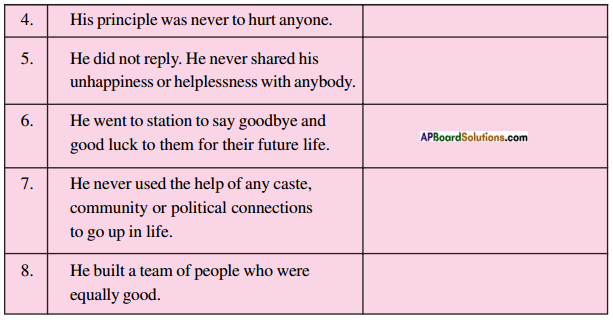
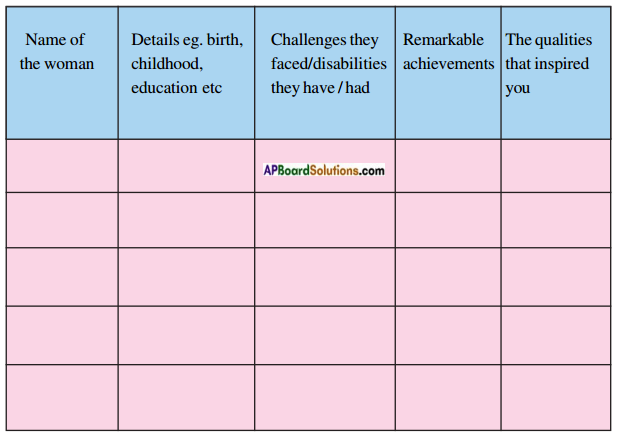



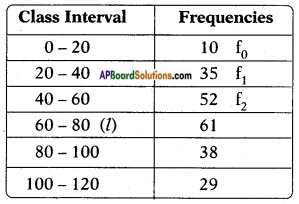



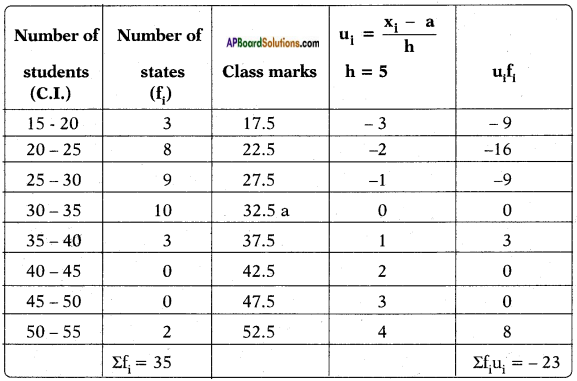

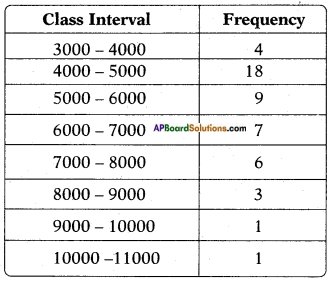

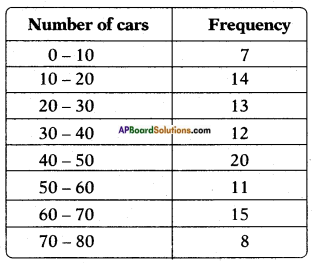
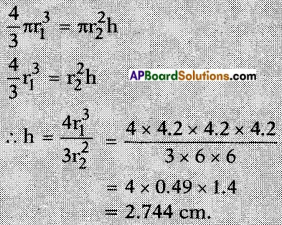






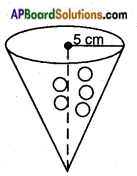
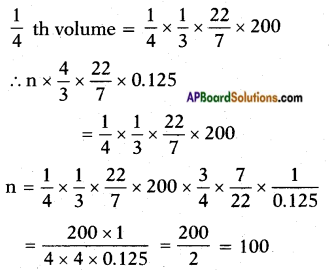


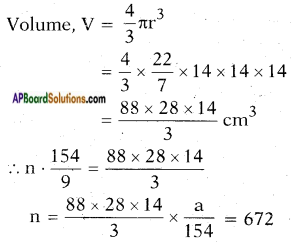
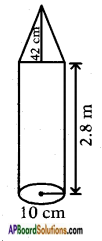

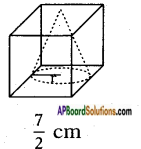

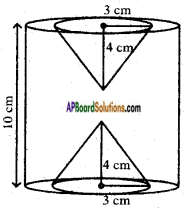
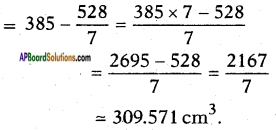

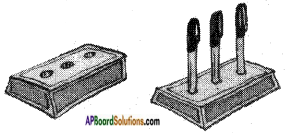
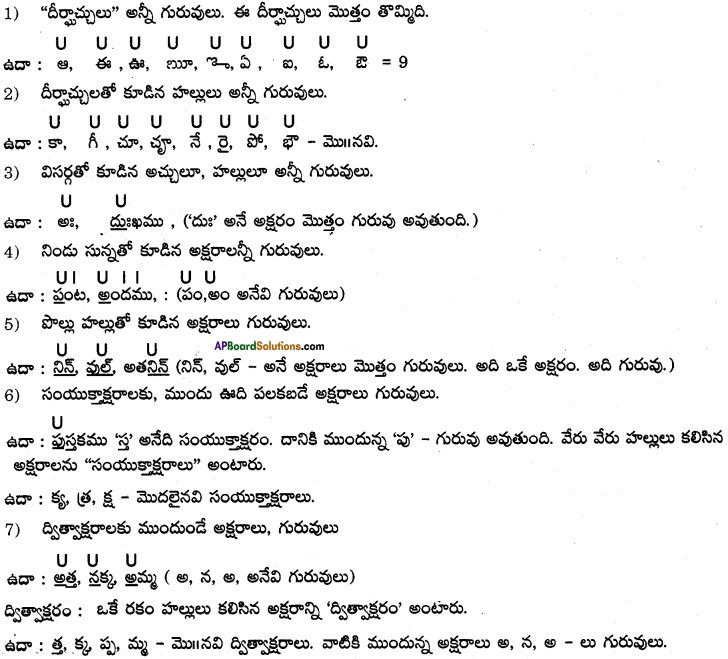
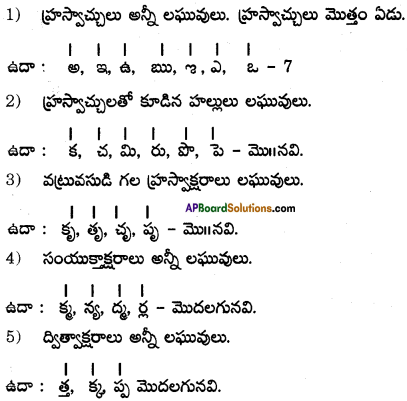



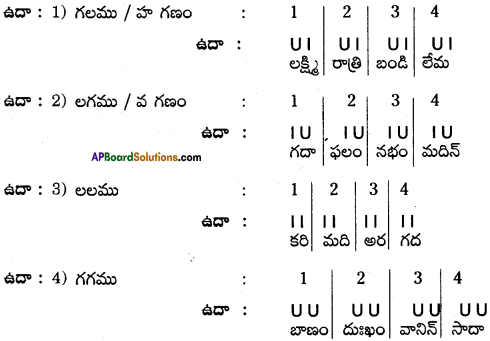


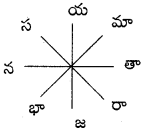










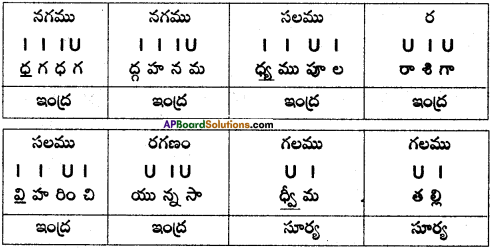










 Answer:
Answer: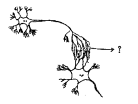 Answer:
Answer: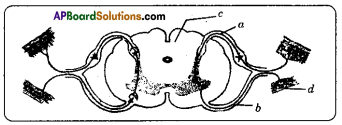 Answer:
Answer: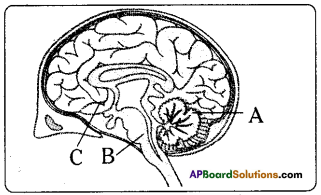 i) This diagram belongs to which system of the body?
i) This diagram belongs to which system of the body?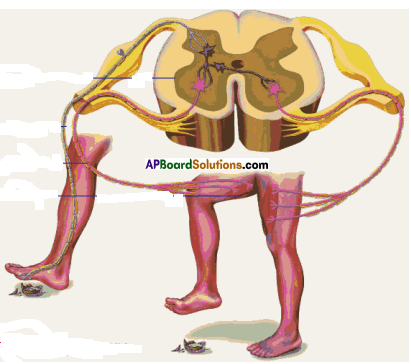 Answer:
Answer: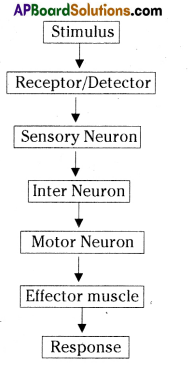
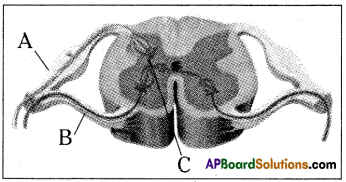 a) To which system does the diagram belong ?
a) To which system does the diagram belong ? i) Brain receives the information, analyses and produces the reponse.
i) Brain receives the information, analyses and produces the reponse.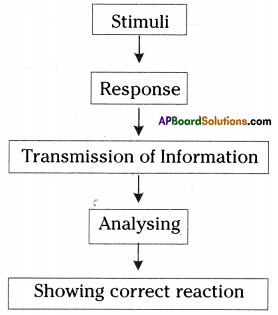
 Functions of different parts of Reflex arc : Reflex arc consists of a receptor, a sensory nerve (afferent) an association neuron or inter neuron, motor nerve (effferent) and a effector organ.
Functions of different parts of Reflex arc : Reflex arc consists of a receptor, a sensory nerve (afferent) an association neuron or inter neuron, motor nerve (effferent) and a effector organ.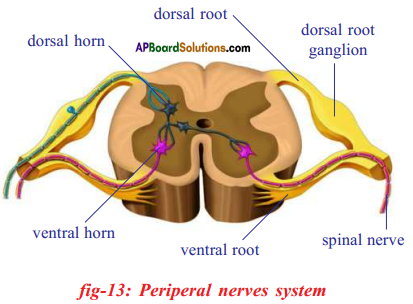


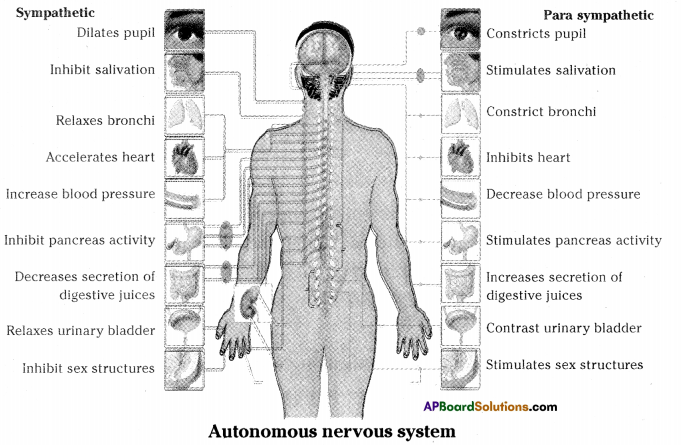 i) To which organs of the body do the nerves go from the ganglions near the vertebral column ?
i) To which organs of the body do the nerves go from the ganglions near the vertebral column ?


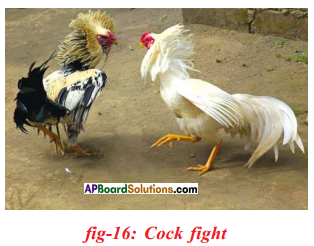
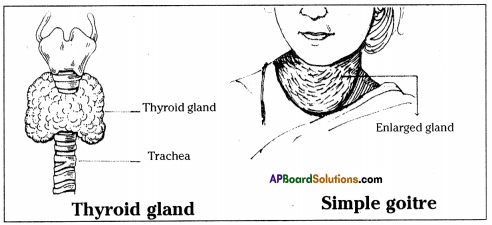

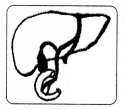 Answer:
Answer: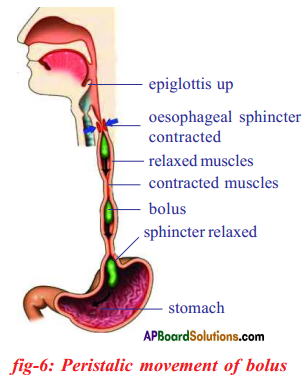 b) Circular muscles and longitudinal muscles of oesophagus help in the movement of food ‘bolus’.
b) Circular muscles and longitudinal muscles of oesophagus help in the movement of food ‘bolus’.
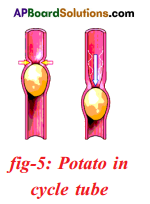 Procedure:
Procedure: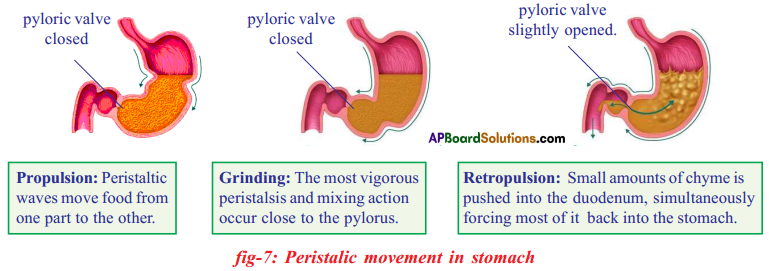
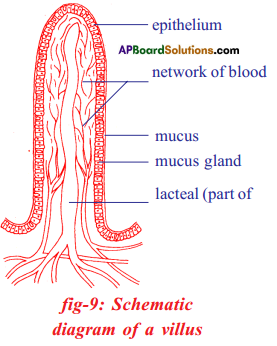

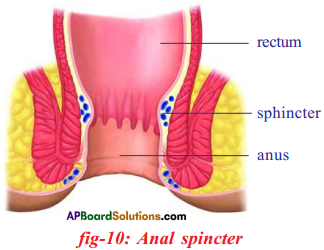
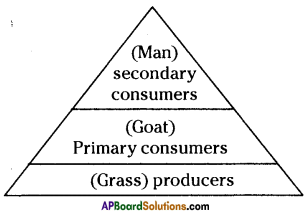

 i) Write any two food chains from the diagram.
i) Write any two food chains from the diagram. Answer:
Answer: i) As per the number of organisms in the tropic level, which group of organisms
i) As per the number of organisms in the tropic level, which group of organisms

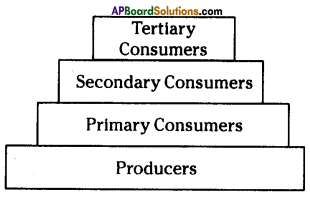
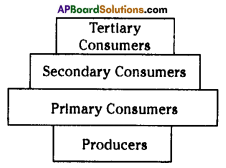

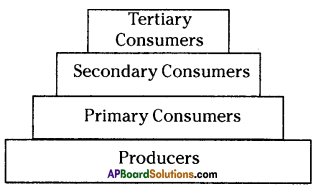
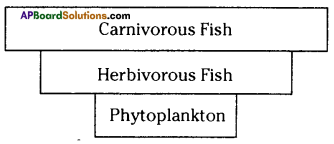


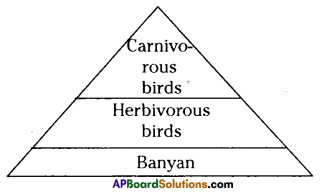

 The pyramid of biomass for the given food chain, at each step 90% of the food is lost. That means 1000 kg of phytoplankton to produce 100 kg of Zooplankton to form 10 kg of fish to produce 1kg of human tissues. The fewer the steps in the food chain the more energy will be for the species at the top.
The pyramid of biomass for the given food chain, at each step 90% of the food is lost. That means 1000 kg of phytoplankton to produce 100 kg of Zooplankton to form 10 kg of fish to produce 1kg of human tissues. The fewer the steps in the food chain the more energy will be for the species at the top.
